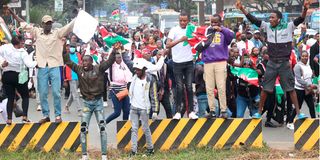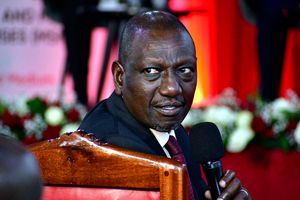
Youth march along Moi Avenue in Nairobi during anti-government protests on June 30, 2024
Nobody comes out of this life alive. Not kings, not presidents, and certainly not Cabinet secretaries for the Interior ministry.
This is a terrible truth to discover in one’s youth, but it can be a force for good or fuel for chaotic change. The shape and form of that change can only be determined by those who hold the levers of State.
The sabre-rattling and credible threats to lives notwithstanding, the youth of Kenya have been speaking out volubly—on the streets and online—to say that their lives as currently constructed are untenable. Those who have come out and paid the ultimate price are previously unknown individuals who are difficult to profile on the basis of ethnicity, race, class, or religion. More importantly, they have underlined the fact that Kenya will not be managed by force of arms.
An edited image of a young woman pole-vaulting over a razor-wire barricade during the June 25 commemoration of last year’s Gen Z protests is a reminder of the truism that as a man thinketh, so is he. Among boda boda riders, and away from official narratives constricted by clampdowns on public broadcasting, legends are emerging of young women pole-vaulting into State House, damn the consequences.
Violence and death
In the past year alone, hundreds of young people who should have had their lives before them have come out to protest about their material conditions and paid the ultimate price. The result has been blood and tears. Still the State insists on meeting them with more threats of violence and death.
The default response has been to crack down on online spaces through killings, abductions, torture and abuse. As Kenya heads to the 25th anniversary of the Saba Saba protests that birthed the second liberation, some 43 per cent of the youth aged between 18 and 35 years believe the country is headed in the wrong direction.
Data from the latest Afrobarometer survey shows that many youth feel left out of Kenya’s economic transformation, if it can be called that. With up to 800,000 youth entering the job market each year, youth unemployment is a critical policy issue.
If, for argument’s sake, the 250,000 individuals armed at State expense were to discharge their firearms on target at the 18 million youth between the ages of 18 and 35, they would kill 1.5 million people. They would still have to contend with 16.5 million angry youth. The math does not add up.
Kenyan youth aged between 18 and 35 years have more education than their elders. Eight in 10 have secondary or post-secondary qualifications, compared to 43 per cent to 58 per cent among older cohorts. However, youth are also more likely to be unemployed. Some 43 per cent say they are looking for work, compared to 19 per cent who are seeking entrepreneurship opportunities. Six in 10 Kenyan youth would like to start their own businesses. Chew on that.
Over the past decade, young people’s evaluations of the government’s performance on their priorities have fluctuated, generally reaching their highest approval levels around 2016-2019 and then falling again. For example, approval of the government’s handling of education declined sharply from a peak of 77 per cent in 2016 and 2019 to 59 per cent in 2024.
Similarly, positive assessments on improving basic health services dropped from 71 per cent in 2016 to 30 per cent in 2024. Approval of crime-reduction efforts rose from 44 per cent in 2014 to 58 per cent in 2019 before declining again to 46 per cent in 2024. Approval of job-creation efforts has been consistently low—between 16 per cent and 31 per cent—throughout the decade.
Choice of jobs
Many young people are actively toying with the idea of emigrating to find opportunities away from home. If they were given a choice of jobs, the most popular route would be to start their own businesses, followed by working in a government or public-sector post, while only about one in 10 young people would opt for jobs in the private sector or a non-governmental organisation. We have no country here.
If the government were able to increase its spending on programmes to help young people, job creation would be the top priority for youth as well as older cohorts. This would be a more effective response to the rise in youth anger and angst away from issuing shoot-to-kill orders. Unfortunately, budgets are increasing for recurrent expenditure to renovate and refurbish State houses and lodges.
It does not take too much to refocus all the ongoing government programmes to respond to youth needs. Government has lost its way in reading its customers, and reset is long overdue.
A reset involves recognising that the old ways of managing public affairs without accountability are behind us. The options are pretty grim: youth have to emigrate or fight to create a republic in their own image. For now, it appears that meeting youth needs is a bridge too far for the William Ruto administration. This only lays the ground for more confrontation, whose result is not a win for either side. It is time to change course.
The writer is board member of KHRC and writes in his individual capacity. @kwamchetsi; [email protected].









